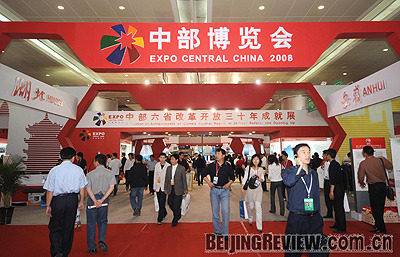|

PLATFORM: The Third Central China Investment and Trade Expo held in Wuhan on April 25-28 surpassed the previous two in terms of size and influence
Increasingly, foreign investors have started to choose central China as an ideal destination in recent years. Statistics from the National Bureau of Statistics show that foreign investment in the six central provinces increased 47.2 percent on average last year, much faster than the country's average of 13.8 percent. Shanxi Province saw the highest growth of 88.6 percent and Henan Province ranked second with a growth rate of about 60 percent.
The high growth in foreign direct investment should be attributed to the "Business Drive Westward" project, said Liu Haiquan, Deputy Director of the Comprehensive Department under the Ministry of Commerce (MOFCOM) to Beijing Review.
When the MOFCOM implemented the project in January 2006, they aimed to encourage around 10,000 overseas companies and companies in eastern China to invest, purchase or start business operations with local partners in central areas in three years. They hoped these efforts would closely link the central Chinese economy to the prosperous eastern region, ease pressures on the eastern region from the shortage of resources and environmental burdens, offer chances for the industrial upgrading in the eastern region, and at the same time take advantage of central China's rich resources and labor to promote the economic growth there.
According to Liu, the MOFCOM encourages large corporations and multinationals in eastern China to establish manufacturing bases in central China, and oversea and domestic investors to develop intensive processing of resource-oriented products and farm produce there. The ministry also encourages companies in the eastern region that contract outward processing trade and OEM services to move the processing business to the central region, thereby giving full play to the cheap land and labor advantages of the central region while making use of the information and network advantages of the eastern region. In addition, the ministry encourages joint efforts between the two regions to build industrial development parks and development zones for some projects to be transferred from the east to the central region.
The MOFCOM has taken some measures to speed up the "Business Drive Westward" project, including an annual expo in one capital city of the six central provinces as a platform for investment, preferential taxation for large logistics companies which invest in west China, and a "green channel" between eastern and central China provinces on highway transportation. The ministry will also offer funds for personnel training.
All these measures have achieved great progress, said Liu. The Third Central China Investment and Trade Expo, which was held in Wuhan, capital of central China's Hubei Province, on April 25-28 attracted 328 of the Fortune Global 500 enterprises and 322 domestic top 500 enterprises, concluding 673 FDI contracts worth $16.17 billion and 766 projects of domestic investments worth 245.12 billion yuan ($35 billion).
Some eminent enterprises in the eastern region have started moving part of their operations to the central region. The Semiconductor Manufacturing International Corp., the world's third largest OEM chipmaker headquartered in Shanghai, for example, just started operation of a 12-inch chip factory in Wuhan's Donghu Hi-Tech Zone in April, and the factory will promote the development of nearly 150 local suppliers, said Liu Chuantie, Deputy Director of the Administration Committee of the Donghu Hi-Tech Zone.
Another example is Taiwan-based Foxconn Technology Group, one of the world's largest manufacturers of electronics and computer products. It started to build Foxconn Industrial Park in the same hi-tech zone at the beginning of this year. With the initial investment of $1 billion, the park is expected to provide 200,000 jobs and have an annual output of more than 100 billion yuan ($14.3 billion) upon its completion in 2010.
Pioneers with foresight have already established themselves in the central region, like Unilever (Shanghai) Co. Ltd. The company has closed five factories in Shanghai in order to slash industrial costs and moved its manufacturing headquarters to Hefei, capital of Anhui Province, since 2002. This move has cut its comprehensive cost by 32 percent, mostly from labor, as in Hefei the monthly average salary is about 600-700 yuan ($85.7-100), only half that in Shanghai.
According to Liu, the central region enjoys convenient transportation and complete infrastructure facilities. It is one of the major grain-producing areas in China, and has abundant energy and mineral resources, with its coal reserves accounting for 40 percent of the national total. The region also enjoys advantages in science, education and human resources, with Wuhan alone boasting 18 universities, 56 research institutes, 49 academicians of the Chinese Academy of Sciences and the Chinese Academy of Engineering, and more than half of the country's professionals in optoelectronic research and development.
However, in recent years, the east has to face increasingly obvious contradictions between its economic growth and limited resources, market and environment, and many labor-intensive industries in the east, owing to increasing labor and land costs, have to be shifted elsewhere. That the central region has become a new favorite destination of investment will ease the uneven development of different regions and narrow the west-east gap. | 